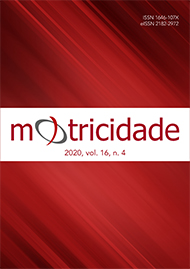Changes in the functional capacity of active and institutionalized elderly
DOI:
https://doi.org/10.6063/motricidade.19630Abstract
This study aimed to observe changes in the functional capacity of the elderly. Eighteen elderly individuals (mean 74.3 years) were divided into two groups: water aerobics (GH, n = 08) and institutionalized (GI, n = 10). Functional capacity was identified through the battery of tests proposed by Rikli and Jones (1999). After the intervention period, both groups showed reductions in the valences evaluated. However, in GI the reductions were more accentuated. For Cardiorespiratory Capacity, Mobility, and Strength of lower limbs, there were reductions for GH of (-4.22%, -9.42%, and -19.23%) and GI of (-52.20, -135.43%, and -28%) respectively. For the Time up and Go test (TUG), statistical effect was present for time (with lower time post vs. pre; p = 0.021) as well as a significant interaction for time*group (p = 0.027), respectively. Physical exercise programs for the elderly can reduce the rate of decline in functional capacity, with healthier aging.
Downloads
Published
Issue
Section
License
The authors of submitted manuscripts must transfer the full copyright to Journal Motricidade / Sílabas Didáticas Editions. Granting copyright permission allows the publication and dissemination of the article in printed or electronic formats, and copyrights start at the moment the manuscript is accepted for publication. It also allows Journal Motricidade to use and commercialise the article in terms of licensing, lending or selling its content to indexation/abstracts databases and other entities.
According to the terms of the Creative Commons licence, authors may reproduce a reasonable number of copies for personal or professional purposes, but without any economic gain. SHERPA/RoMEO allows authors to post a final digital copy (post-printing version) of the article on their websites or on their institutions' scientific repository.


